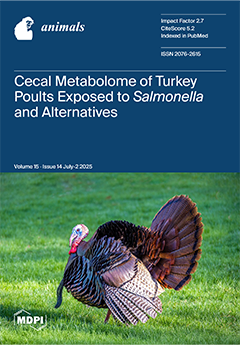Optimizing the metabolizable protein level in ruminant diets represents a promising strategy to increase nitrogen use efficiency and mitigate environmental pollution. This study explored the impacts of varying metabolizable protein (MP) levels on amino acid (AA) balance, nitrogen (N) utilization, and the ruminal microbiota in Hu lambs. Fifty-four female Hu lambs of 60 d old, with an average body weight (BW) of 18.7 ± 2.37 kg, were randomly allocated to three dietary MP groups: (1) low MP (LMP, 7.38% of DM), (2) moderate MP (MMP, 8.66% of DM), and (3) high MP (HMP, 9.93% of DM). Three lambs with similar BW within each group were housed together in a single pen, serving as one experimental replicate (
n = 6). The feeding trial lasted for 60 days with 10 days for adaptation. The final BW of lambs in the MMP and HMP groups increased (
p < 0.05) by 5.64% and 5.26%, respectively, compared to the LMP group. Additionally, lambs fed the MMP diet exhibited an 11.6% higher (
p < 0.05) average daily gain than those in the LMP group. Increasing dietary MP levels enhanced (
p < 0.05) N intake, urinary N, retained N, and percent N retained, but decreased apparent N digestibility (
p < 0.05). Urinary uric acid, total purine derivatives, intestinally absorbable dietary protein, microbial crude protein, intestinally absorbable microbial crude protein, and actual MP supply all increased (
p < 0.05) with higher MP values in the diet. The plasma concentrations of arginine, lysine, methionine, phenylalanine, threonine, aspartic acid, proline, total essential AAs, and total nonessential AAs were the lowest (
p < 0.05) in the LMP group. In the rumen, elevated MP levels led to a significant increase (
p < 0.05) in the ammonia N content. The relative abundances of
Candidatus_Saccharimonas,
Ruminococcus, and
Oscillospira were the lowest (
p < 0.05), whereas the relative abundances of
Terrisporobacter and the
Christensenellaceae_R-7_group were the highest (
p < 0.05) in the MMP group. In conclusion, the moderate dietary metabolizable protein level could enhance growth performance, balance the plasma amino acid profiles, and increase nitrogen utilization efficiency in Hu lambs, while also altering the rumen bacterial community by increasing beneficial probiotics like the
Christensenellaceae_R-7_group.
Full article






